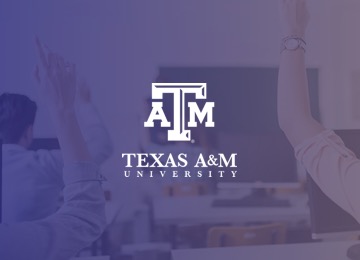5 mins
Texas A&M Implements Workday
The Texas A&M University System needed to update its legacy human capital management system. The organization decided to leverage the Prosci Methodology for the enterprisewide Workday implementation, and to develop a repeatable change management framework for future projects.

58,000
Users move to new Workday system
35
35-year-old payroll system eliminated
11
University sites integrated
Prosci Solutions
Interested in learning more about how we can help your organization succeed at change?
Let's TalkThe Texas A&M University System is one of the largest systems of higher education in the United States. It is comprised of 11 universities, seven state agencies, one health science center, and one system administrative office. It operates with a budget of $4.5 billion per year, affecting 149,000 students, 48,000 faculty, staff, and student workers, and 10,000 retirees who receive benefits.
Challenge

In 2015, the A&M System was still reliant on a payroll system that was 35 years old, expensive to maintain, and difficult to adapt. Additionally, this system no longer followed business best practices. The A&M System selected Workday as the right cloud-based software for its new human capital management system. Workday would integrate HR, payroll, and other solutions and would also simplify and standardize processes while minimizing overhead.
The Challenge
To reduce risk in operating and maintaining legacy systems, lower operating costs, and
realize efficiencies by replacing a legacy human capital management system with a cloud-based alternative.
Prosci’s ADKAR® Model is the best framework to prepare individuals to accept a significant change and thrive in a new way of doing business.
— Leslie W. Lenser, Executive Director, Program and Project Management
On December 17, 2017, the A&M System will go live with Workday’s HCM product.
It was no secret that the legacy payroll system needed to be upgraded, but several obstacles delayed the decision to replace it:
- Large stakeholder groups and long review cycles slowed the decision-making process (a characteristic of higher education that impacted the project going forward)
- Stakeholders were not aligned on the right solution for the new system
- Financial leaders from the A&M System and each university and agency needed to decide how to pay for the new system
Solution

Partnership with Prosci
The executive director of program and project management used the Prosci methodology to guide much of her change management work. Because the Workday implementation would impact over 58,000 end users, the project team decided to apply a formal change management approach for the first time at the A&M System. As a result, creating a repeatable template for change management on a project became one of the expected outputs of the implementation.
The Solution
- Certify the project change lead in change management
- Implement the Prosci 3-Phase change management methodology
- Use the Prosci ADKAR® Model to structure communications, training, and resistance management
Application
Using the Prosci 3-Phase Process and Prosci ADKAR Model as guides, a core group focused on change management began outlining a change management plan with the goal of integrating it with the project team’s milestones.
Stakeholder identification and assessment
The change management team used Prosci tools to identify and assess the readiness of the stakeholders who would be most impacted by the project. This included 331 full-time HR payroll and benefits employees, 2,014 HR department liaisons and 8,546 people managers. During these assessments, the change management team also completed an initial assessment of the communication and training needs each impacted group would require.
Proactive resistance management
Following change management best practices, the change management team also assessed change impacts and likely areas of resistance. They tailored special tactics to address the most universally anticipated resistance points. For example, to address resistance to change caused by unfamiliarity with the new software and processes, the change management team ensured that all major changes were communicated before training. They also ensured that the most impacted employees heard about key changes three to five times before going live. In addition, coaches with expertise in Workday’s business processes and security roles met with each member over a 13-week period to review the most common business processes and surface resistance and questions.
Sponsorship coalition and change network
There was another area of resistance that would prove more difficult to mitigate: many employees identified first with their university or agency and second (if at all) with the overarching A&M System. They were, therefore, wary of changes brought in from the System Office and did not respond to sponsorship from this office.
To address this, the team brought together the HR Officer and Chief Financial Officer of each of the system’s 11 universities, seven state agencies, and the health science center to become part of an Executive Advisory Committee (EAC). These representatives provided executive-level buyin, provided input on all major decisions, and formally accepted the design, the prototypes, and the system testing results. They became sustaining sponsors of the change throughout the project.
The EAC was supported by local change leaders and agents who, with the EAC, received regular briefings on the project, became the face of the project to their employees, and locally deployed the communications, readiness activities and resources that the project team had developed for them. Additional influential leaders at each university and agency, and leaders for key functional areas, were also identified. Touchpoints were set up between them and project leaders.
Training strategy and plan
Using the Prosci ADKAR Model as a guide, the change management team designed a training curriculum around the new software based on the following phases: awareness and desire, knowledge and ability, and reinforcement. The primary emphasis of the training plan focused on the 331 full-time HR, payroll and benefits employees, with classroom training scheduled on location at each system member site.
Due to time, budget and geographic constraints, the 2,014 HR liaisons (serving as department admins in their “real” job) participated in virtual classroom training while all 8,546 managers received eLearning modules. All universities and agencies were given a list of recommended readiness activities to equip their employees for the change. These activities included drop-in learning labs, Q&A sessions, and local communications on which employees should do which work when overlapping security roles allowed more than one employee to do the same work.
Communication strategy and plan
When creating the communications plan, the change management team relied on the EAC
and local change leaders as primary deliverers of change messages. Using these representatives embraced the loyalty and identity that employees at each university and agency felt. It also followed best practices by allowing messages to come from preferred senders - people who employees most identified with.
In addition to choosing the correct senders of change messages, all training activities and
communications were carefully timed in phases, guided by the milestones of the ADKAR Model. General and targeted awareness happened in September, and skill-building activities took place from October until November.
Metrics
When evaluating how to gauge project and change management progress, the team decided to formally track:
- Perception of likelihood of project success, confidence in leadership, and knowledge of
where to find information about the project - Completion and success of the communications plan
- Completion of recommended readiness and training events
The team tracked these metrics via a series of three surveys, as well as change agent self-reporting and training completion statistics. All metrics were recorded in a readiness tracker, which visually demonstrated progress and challenge areas.
Informal tracking happened through one-on-one conversations with additional influential leaders and project status presentations to influential groups across the A&M System.
Results

Thanks to robust communications and sponsorship plans that began twenty-six months before go-live, confidence in leadership and perception of the likelihood of project success has remained high through the first two of three surveys. This was a noticeable shift from other system-wide projects.
Results Highlights
- Over 77% of leadership, managers, staff, and core impacted employees had received
recommended communications four months before go-live - 70% of leadership, managers, and core impacted employees had completed recommended readiness activities four months before go-live
- Project is on schedule and on budget to successfully launch on time
On the first survey (completed 10 months before go-live), surveyed groups overall scored 3.92 on a 5 point Likert-scale that they understood the benefits of the new software, were actively promoting it, and believed that they would receive adequate training on how to use it. The second survey (completed six months before go-live), showed a slight drop to 3.84, indicating that people were really beginning to learn about the change and how it would impact them. The third survey is happening in late October and early November.

Founded in 1994, Prosci is a global leader in change management. We enable organizations around the world to achieve change outcomes and grow change capability through change management solutions based on holistic, research-based, easy-to-use tools, methodologies and services.


